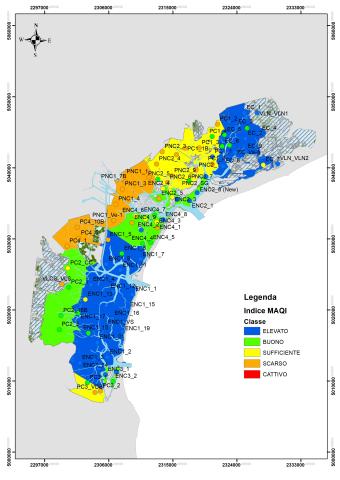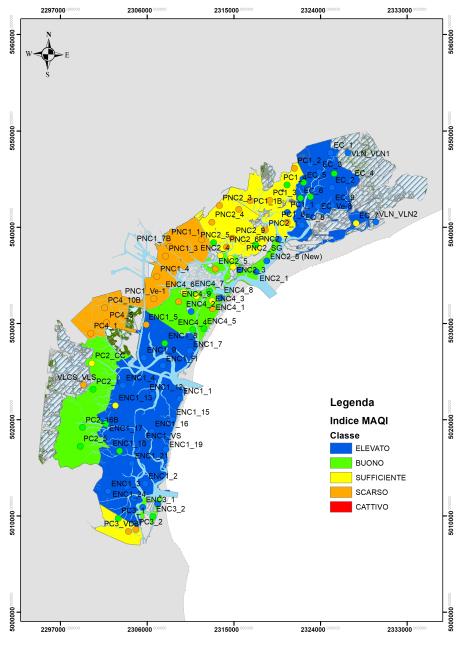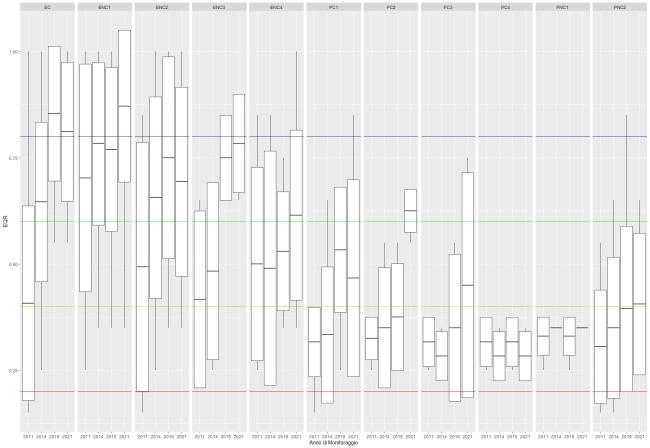Panel 1
Valentina Bernarello, Andrea Bonometto, Rossella Boscolo Brusà, Federica Cacciatore, Federica Oselladore, Emanuele Ponis
The MaQI (Macrophyte Quality Index) (Sfriso et al., 2014) formally adopted by Italy for the classification of the ecological status of transition environments under Directive 2000/60/EC, integrates the two organic quality elements macroalgae and aquatatal fanerogages.
The MaQI responds to anthropogenic pressures affecting transition areas and describes the ecological quality status in 5 classes: high, good, sufficient, scarce and bad.
The monitoring of macrophytes for the application of the MaQI index has been active in the Venice Lagoon since 2011 with a three-year frequency. In the three-year period 2020-2022 (21 data) of the eleven natural water bodies of the Venice Lagoon, two were in a “high” state, four in a “good” state, three “sufficient” and two in a “poor” state. The trend, although statistically not significant, is overall positive, considering the improvement of the state of some bodies of water.
The Macrophyte Quality Index is a multimetric index, based on: number and percentage of sensitive macrolagal species; relative abundance of Rhodophyta and Chlorophyta; percentage coverage of macroalgae; percentage coverage of the different species of aquaetal fanerogate (ISPRA, 2011).
This index is used to provide a synthetic ecological classification of the ecosystem through the use of the structural parameters (coverage, composition and abundance) of the mobile background macrophytic community. The MaQI, consolidated by a robust bibliographic support, is able to summarize the complexity of the mobile bottom plant communities, allowing an ecological reading of the ecosystem in question.
The index is applicable to all Italian water bodies with an average annual salinity of more than 5 and has been intercalibrated with other Member States to ensure the comparability of the results at Mediterranean level.
The value of the MaQI varies between 0 and 1, and corresponds to the Ecological Quality Report (RQE) required by the Water Framework Directive 2000/60/EC. Class limits are defined and reported in the reference legislation DM 260/2010.
The application of the index in the Lagoon of Venice takes place through the calculation of the average RQE values of the stations of each of the eleven natural water bodies according to which the lagoon was divided: EC – Palude Maggiore, PC1 – Dese, PC4 –Teneri, PC2 – Millecampi, PNC1 – Marghera, PNC2 – Tessera, ENC2 – Bocca di Lido, ENC4 – Sacca Sessola, ENC1 – Centro Sud, ENC3 – Chioggia, PC3 – Val di Brenta.
Classify the ecological quality status of transitional water bodies using the biological quality elements "macroalgae" and "aquatic blush".
Directive 2000/60 / EC
D.Lgs. 152/2006 and ss.mm.i.i
Decision 2018/229 / EU
Directive 2000/60/EC (received by Legislative Decree 152/2006 and subsequent amendments) establishes a regulatory framework for all Member States, for the protection of inland surface water, transitional waters, coastal and underground waters that aims at the improvement and restoration of all surface water bodies, for artificial water bodies and those strongly modified, in order to achieve a good state of the surface waters.
The MaQI index has been formally identified for the classification of the Macrophyte Biological Quality Element in Italian transitional waters by DM 260/2010 and included in Decision 2018/229/EU following the intercalibration process in the Mediterranean.
Panel 2
Sfriso, A., Facca, C., Ghetti, P.F. (2007). Rapid Quality Index, based mainly on Macrophyte Associations (R-MAQI), to assess the ecological status of the transitional environments. Chemistry and Ecology, 23 (6): 1-11.
Sfriso, A., Facca, C., Ghetti, P.F. (2009). Validation of the Macrophyte Quality Index (MaQI) set up to assess the ecological status of Italian marine transitional environments. Hydrobiologia, 617, 117-141.
Sfriso, A., Facca, C., Bonometto, A., Boscolo, R. (2014). Compliance of the Macrophyte Quality Index (MaQI) with the WFD (2000/60/EC) and ecological status assessment in transitional areas: The Venice lagoon as study case. Ecological Indicators 46, 536–547.
ISPRA, 2009. Implementazione della Direttiva 2000/60/CE - Classificazione dello stato ecologico dei corpi idrici delle acque marino costiere e di transizione.
ISPRA, 2010. Implementazione della Direttiva 2000/60/CE - Linea guida per l’applicazione dell’indice MaQI.
ISPRA, 2011. Protocolli per il campionamento e la determinazione degli elementi di qualità biologica e fisico-chimica nell’ambito dei programmi di monitoraggio ex 2000/60/CE delle acque di transizione.
ISPRA-UNIVE, 2012. Variazioni del Macrophyte Quality Index (MaQI) a seguito dei risultati dell’intercalibrazione nell’Ecoregione Mediterranea (Med-GIG).
Constant updating of the species list used.
Data quality assessment
ARPAV (Arpa Veneto)
SINTAI
www.arpav.it
The Lagoon of Venice
2011-2013; 2014-2016; 2017-2019; 2020-2022
Indicator assessment
or the application of the MaQI it is necessary to determine the following parameters:
- Systematic recognition of macroalgal taxa at the species level and determination of the number and percentage of sensitive taxes present (ISPRA, 2010);
- Total coverage and relative abundance of the dominant macroalgae. It is sufficient to discriminate between the 5% or ? coverage and the relative abundance of Chlorophyta and Rhodophyta;
- Relative percentage recognition and coverage of individual species of phanerow.
The metrics are combined with each other via a two-way matrix, for macroalgae and fanerogames respectively, which directly returns the value of the RQE and the state of the EQB (ISPRA, 2012). The value of the MaQI varies between 0 and 1. The class limits are reported in the reference legislation (Legislative Decree 152/2006 and ss.mm.ii.), which defines 5 classes (high, good, sufficient, scarce, bad).
From the analysis of the MaQI index at the body of water body, it is observed that in the three-year period 2020-2022 (data 2021) 2 water bodies are in the “poor” ecological state, 3 “sufficient”, 4 “good” and 2 in “high” state (Figure 1).
There are 9 out of 11 bodies of water that throughout the period analyzed (2011-2022) show an increase in the values of the MaQI index, in some cases with an improvement in the quality class (Figure 2). Compared to the previous three-year period (2017-2019) the water bodies in “poor” state decreased (from 5 to 2) and increased those in sufficient state (from 2 to 3), good (from 3 to 4) and elevated (from 1 to 2) (Figure 2).
The trend, although not statistically significant (Her Kendall test with p-0.05 for all CIs), from a purely descriptive point of view, seems to show an improvement in the quality of the bodies of water over the years, throughout the Lagoon, except for the central area propying the industrial area of Porto Marghera (PNC1) water body, the area of the Teneri (PC4 water body) and the water body influenced by the river Dese1. For all three bodies the classifications remain unchanged compared to the previous three years.
The EC-Submpus Major water body constantly increases RQE values from 2011 to 2019 going from “sufficient” to “high”, quality class that is maintained as such in 2021, albeit with a decrease in RQE scores.
ENC2 – Bocca di Lido improves in class, from “sufficient” to “good”, between 2011 and 2014. In the following monitoring (2019 and 2021) the “good” state is reconfirmed. ENC1 was “good” from 2011 to 2019 and in the last monitoring cycle it improves until it reaches the “high” state.
From 2014 to 2019, the water body ENC3 - Chioggia improves from "sufficient" to "good" and remains so in 2021.
PC2 – Millecampi and PNC2 – Card, which do not have a variation in the allocation class in the 3 monitoring cycles from 2011 to 2019 (they always remain in a “poor” state), however, show a constant increase in RQE values until they reach the “good” state for PC2 and the “sufficient” state for PNC2 in 2021. ENC4 – Sacca Sessola also remains in quality “poor” in the first three years, until it passes to “good” in 2021. Finally, PC3 – Val di Brenta remains “poor” in the first three-year period and improves in the state of “sufficient” in the last three years (Figure 2).
Data
Figure 2: Box plot of MaQI values determined in 2011, 2014, 2019 and 2021 in the water bodies of the Venice Lagoon
ISPRA - ARPAV
EQR = Ecological Quality Ratio. The colored bands correspond to the limits defined by Legislative Decree 152/2006 ss.mm.ii (blue = high, green = good, yellow = sufficient, orange = poor, red = bad)



The application of the MaQI index in the water stations and bodies of the Venice Lagoon provides a general assessment of the macrophytic component for the year 2021, referring to the entire three-year period 2020-2022 (Figure 1).
In the three-year period 2020-2022 (21st data), based on the EQB Macrofite (macroalgae and aquatic fanerogages) were in a “good” or “high” state 6 water covers (ENC1, ENC2, ENC3, ENC4, EC and PC2) out of 11. The ecological conditions of macrophytes generally appear to be improving with an increase in RQE in almost all water bodies, except for EC, ENC2, PC1, PC4, and PNC1 (which do not change the quality state) (Figure 2).